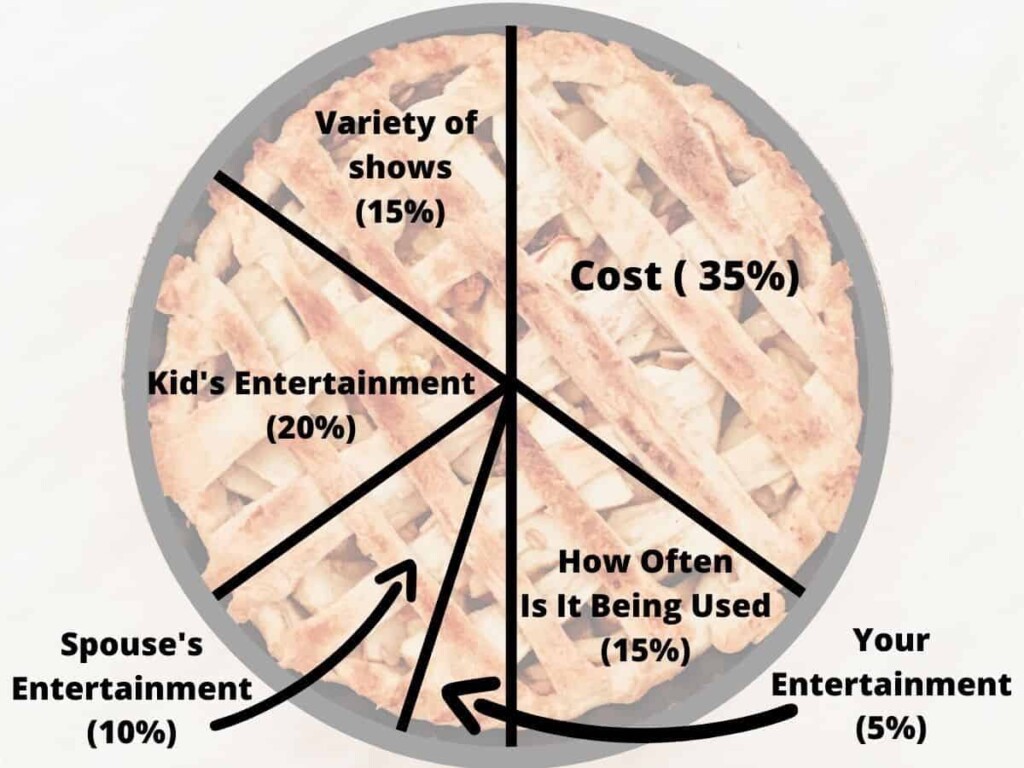
The hardest part of any personal budget is deciding which expenses are worth keeping and which one needs to go. Some costs are very easy to determine if it’s worth keeping or not. But others are not.
So how do you decide which expenses you should cut from your budget? List your expenses and rank them on a scale of 1 to 5. Where 1 is “I need it to live.” or “It helps me make money!” and 5 is “I can’t believe I’m paying for this!”. If you ranked an expense a 1 or 2, then you should keep it. If you gave it a 4 or 5, then you should remove it. If you ranked an expense as a 3, then you probably need to give it some more thought and compare the pros and cons before deciding.
But yo BS … I did what you said. But I’m still having trouble trying to figure out how to compare the pros and cons to make a decision.
Don’t worry. I got a little method that you can use to help you decide what you should do. Its called a Decision Matrix!
How can you not trust this method! I mean, the word “Decision” is in its name!
Before we jump right into how to make a decision matrix, I thought it would be best to provide an example of a situation to give context on how to set this up for yourself.
Example: Cable TV, Netflix, or Disney Plus
In this example, let’s say that your spouse and you are reviewing the household budget. You’re ranking expenses using the 1 to 5 method that I recommended to determine if the cost is worth keeping or not. Then you realized that you’re paying for Cable TV, Netflix, and Disney Plus, which is costing you about $125 per month.
Something clearly needs to go but what?
There are so many pros and cons of the three services. Perhaps your spouse likes watching sports on TV, you are hooked on a few different Netflix originals, and your kids are hooked on Disney Plus. Not to mention you got things like cost, how much usage does each service get, and how do you consider your kids’, spouse’s, and your entertainment to make a decision.
Well, good thing you remembered this handy little method that BS mentioned called the decision matrix.
Roll Up Your Sleeves, It’s Time To Build A Matrix
The first thing you need to do is roll down your sleeves! Building a decision matrix is not hard. Once you do a few of them, you can hammer them out pretty quickly.
If you got a decision, you could use a decision matrix. It does not matter if you have one thing to consider or a hundred things to consider before making a decision … a decision matrix can help you out.
What You Need To Start
All you need to start building a decision matrix is:
- Paper
- Pen
- Cellphone or calculator
That is right. I said calculator! If you’re getting flashbacks from your high school math classes, then don’t worry, this is BS’s simple math.
Step 1: List your Considerations
Using our example, the first thing you need to do is just list all the different things you need to consider to make a decision.
At this point don’t over think it … just list it.
Let’s say you came up with:
- Cost
- How often is it being used?
- Do you find it entertaining?
- Does your spouse find it entertaining?
- Do your kids find it entertaining?
- A wide variety of shows/movies to watch?
Here I came up with only 6 main considerations that you would probably consider before making a decision. You could have fewer considerations or more. It does not matter.
Now create a table from your list of consideration.
| Cable TV | Netflix | Disney Plus | ||
|---|---|---|---|---|
| Decision Score: | ||||
| Cost | ||||
| How often is it being used? | ||||
| Do you find it entertaining? | ||||
| Does your spouse find it entertaining? | ||||
| Do your kids find it entertaining? | ||||
| A wide variety of shows/movies to watch? |
Step 2 Give Each Consideration A Weighting
Applying a weighting is essentially assigning each consideration a percentage. Larger the weighting, the more influence it will have on the decision matrix.
There are no rules when assigning a weighting but one. All the percentages you assign must add up to 100%.
Think of this as an apple pie. Each consideration is a slice, and the weighting you apply determines how big the slice of pie is.

Continuing with our example, let’s say here is the weighting for each consideration that you came up with.
| Cable TV | Netflix | Disney Plus | ||
|---|---|---|---|---|
| Decision Score: | ||||
| Cost | 35% | |||
| How often is it being used? | 15% | |||
| Do you find it entertaining? | 5% | |||
| Does your spouse find it entertaining? | 10% | |||
| Do your kids find it entertaining? | 20% | |||
| A wide variety of shows/movies to watch? | 15% |
Since in this example, the whole issue was “paying too much for all three services” so it was only fitting to have cost as the most weight consideration.
The next most weighted consideration is your kid’s entertainment. Mainly because if they are not entertained, then you’re just going to have nothing but headaches.
Coming in last is your entertainment because you are that kind of person.
Step 3: Ranking Each Consideration
In this step, we are going to rank how each service meets each consideration.
Before we can start to rank each service, we first need to come up with a scale that makes sense to you. For our example, let’s use a range between 0 to 3.
0 – Does not meet your needs at all
1 – Somewhat meets your needs
2 – Meets most of your needs
3 – Meets all your needs
How you create your range does not matter. It could be 0 to 10, 0 to 100, and even 0 to 12,389. Just as long as the scale makes sense to you, then you are good to go.
So lets go ahead and populate the decision matrix using this 0 to 3 scale.
| Cable TV | Netflix | Disney Plus | ||
|---|---|---|---|---|
| Decision Score: | ||||
| Cost | 35% | 1 | 2 | 3 |
| How often is it being used? | 15% | 2 | 2 | 2 |
| Do you find it entertaining? | 5% | 2 | 3 | 0 |
| Does your spouse find it entertaining? | 10% | 3 | 1 | 0 |
| Do your kids find it entertaining? | 20% | 0 | 1 | 3 |
| A wide variety of shows/movies to watch? | 15% | 3 | 3 | 2 |
Cable TV gets no love from your kids, and it costs the most out of the three services. But the good thing about cable TV is that it has a wide range of different shows to watch, not to mention the sports channels.
Netflix got decent scores all around, but there are not many shows on Netflix that your spouse and kids like to watch.
Disney Plus was the cheapest service, and your kids love the shows, but you and your spouse could care less about watching Disney, and nothing on there really entertains you guys.
Step 4: Finding Out The Decision
I hope you are as excited as I am to find out the recommended answer to our example.
But before we can find out the decision we first must do some math.
So grab a cup of coffee and open the calculator app on your phone. We are going to add up the scores for each service.
How to Calculate the Total TV Score:
1 x 35%/100 + 2 x 15%/100 + 2 x 5%/100 + 3 x 10%/100 + 0 x 20%/100 + 3 x 15%/100
Total TV Decision Score = 1.5
How to Calculate the Total Netflix Score:
2 x 35%/100 + 2 x 15%/100 + 3 x 5%/100 + 1 x 10%/100 + 1 x 20%/100 + 3 x 15%/100
Total Netflix Decision Score = 1.9
How to Calculate the Total Disney Plus Score:
3 x 35%/100 + 2 x 15%/100 + 0 x 5%/100 + 0 x 10%/100 + 3 x 20%/100 + 2 x 15%/100
Total Disney Plus Decision Score = 2.25
Perfect! now enter the decision scores you’ve calculated in the decision score row for each service and you get:
| Cable TV | Netflix | Disney Plus | ||
|---|---|---|---|---|
| Decision Score: | 1.5 | 1.9 | 2.25 | |
| Cost | 35% | 1 | 2 | 3 |
| How often is it being used? | 15% | 2 | 2 | 2 |
| Do you find it entertaining? | 5% | 2 | 3 | 0 |
| Does your spouse find it entertaining? | 10% | 3 | 1 | 0 |
| Do your kids find it entertaining? | 20% | 0 | 1 | 3 |
| A wide variety of shows/movies to watch? | 15% | 3 | 3 | 2 |
The Matrix has spoken and the winner is Disney Plus!
Well, the good news is that you get the Marvel movies within Disney Plus. I guess your spouse will need to stream the sports games on the computer, and you will just learn to love watching Mickey and Mini mouse.
Making Sense Of An Unclear Decision
I hope this exercise demonstrates the usefulness behind creating a decision matrix when deciding what expenses you should cut from your budget, especially if you got costs for a similar service.
We started with three services and six different considerations. Just thinking about it could be overwhelming. But as you begin working through the matrix, the information starts to become more apparent.
As you work through the matrix, you might have realized that a consideration might mean more to you or less than what you initially thought. That is perfectly normal, and you can make the changes as you go.
The best part of learning how to create a decision matrix is that it can be used for any decision in life where the choice is unclear.
